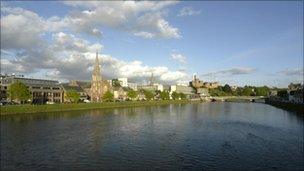Force numbers 'going back to 80s'
- Published

The force could return to the 80s - the setting for Ashes to Ashes - in terms of officer numbers
Like modern day DI Alex Drake in time-bending police drama Ashes to Ashes, Northern Constabulary could find itself being dragged back to the 1980s.
Fortunately, it will not be a throwback to policing methods of that decade, or some of the extreme measures of the fictional Fenchurch East CID officers headed by hard man DCI Gene Hunt.
What has been forecast by the Scottish Police Federation is the force's strength declining to the levels of 30 years ago because of threatened budget cuts.
Northern must find savings of £4.7m in the next financial year. Reducing staff and closing 16 stations have been proposed.
Chief Constable Ian Latimer has described the challenges the force faces as "unprecedented".
David Ross, Northern's SPF secretary, said the affect of cuts planned in the 2011-12 budget could be felt for years.
He told BBC Radio Scotland: "Potentially within five years numbers of police officers we have in Scotland and in Northern Constabulary will go back to the 1980s.
"From 800 officers we have now we are going back to 640 to 650."
Mr Ross added: "What the public want and expect is to see police officers on the street.
"If you reduce officers across the Northern Constabulary force area the reality is the public will see significantly less police officers patrolling the streets."
Record high
Until now, officer numbers were rising at the UK's most northerly force.
In 2001, the figure was 650 and by 2006 it had grown to 716.
Recruitment of further new constables pushed numbers from 787 in March 2008 to 801 by August last year - a record high.
Populations in some parts of the force area have also been on the rise, while other areas such as the Western Isles have concerns about depopulation.
Highland - one of the local authority regions covered - is among those experiencing a boom.
Its population has mushroomed from 99,762 residents in 1991, to 102,297 in 2001 and now 208,914 according the latest census figures.
Warnings of tough financial times in the future for the police, meanwhile, can be traced back to 2006 when Mr Latimer gave a presentation to a meeting of the Northern Joint Police Board.

The Highland Council area has experienced rising population
According to the minutes of the meeting, external, the chief constable told members how he planned to build on the force's strengths.
However, he also said it was important for the board to recognise there would potentially be no growth in funding in the future for forces throughout Scotland.
Between then and now there has been an economic downturn tail spinning into recession to add to the pressures on public spending.
Cold case
In the latest edition of the force's online magazine, Northern Light,, external Mr Latimer said budget cuts threaten Northern Constabulary's record for low crime.
He said the force area was one of the safest in the UK and had one of the highest crime detection rates.
But in the face of cuts, Mr Latimer said he did not expect crime rates to continue to fall for much longer.
On the positives, the technology available to aid crime fighting today has advanced markedly since the 1980s and is playing a part in a cold case review of man's unsolved murder in Lochaber in 1989.
Mr Latimer has also said those who need a police officer would continue to get one.
Still, for many in the communities where stations have been earmarked for closure the bricks and mortar presence of the police is likely to be missed.
Spean Bridge Community Council has spoken of the reassurance their station gives residents. The village has had a station since the 1800s.
So, like an episode of Ashes to Ashes, the past and what might happen in the future will haunt decisions on the shape of Northern Constabulary.
- Published13 October 2010
- Published12 October 2010
- Published14 July 2010
- Published26 May 2010